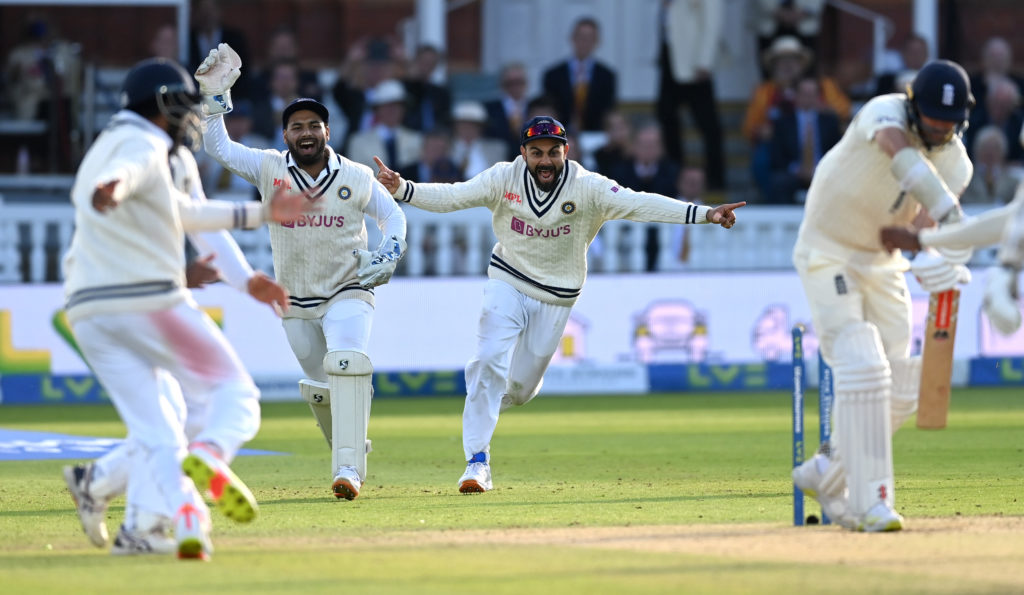India head into the third Test against England at Headingley, starting on Wednesday, 1-0 up in the five-match campaign following a dramatic 151-run win after a dominant display on the last day at Lord’s.
Below AFP Sport looks at three aspects of the series that could have a bearing when the teams meet in Leeds:
India’s pacemen proving their worth
When India won their first Test series in England in 1971, spinners dominated their attack with Srinivasaraghavan Venkataraghavan, Bhaghwat Chandrasekhar and left-armer Bishan Bedi sharing 37 wickets between them during a 1-0 triumph in a three-match campaign.
Fast forward 50 years and the picture is markedly different. After two Tests, India’s bowlers have taken 39 wickets (in addition to a run-out) and yet not one has fallen to a spinner, even though Ravindra Jadeja has featured in both matches.
And while star off-spinner Ravichandran Ashwin has remained on the sidelines, India’s all right-arm pace attack has had plenty of variety, be it the awkward angles generated by Jasprit Bumrah, the accuracy of Mohammed Shami or the swing of Mohammed Siraj.
It was Siraj who led the attack at Lord’s with an eight-wicket haul, prompting former England fast bowler Steve Harmison, broadcasting on ESPNCricinfo, to say: “He’s a Duracell battery, Mohammed Siraj … from the first ball to the last ball, he’s at it.
“He pitches it up, swings it away.”
And such is India’s strength in depth, when injured pace-bowling all-rounder Shardul Thakur was left out from the side that drew the first Test in Nottingham, experienced quick Ishant Sharma returned to take five wickets at Lord’s.
England, by contrast, are now without Stuart Broad, Jofra Archer, Olly Stone and Chris Woakes, with star all-rounder Ben Stokes out of action due to mental health issues.
Root’s lone resistance
England captain Joe Root could end up having one of the best years of any Test batsman while his team, winless in seven matches in the format, have one of their worst.
So far this series Root has scored 661 runs including two hundreds at an average of 128.66, way ahead of England’s next best tally – 252 runs at 29.50 from Yorkshire teammate Jonny Bairstow.
England have dropped Dom Sibley for Headingley following the opener’s dismal run of low scores, averaging 19.77 in 10 Tests this year, and have called up Dawid Malan.
Haseeb Hameed, who managed just nine runs on his Test return at Lord’s batting at No 3, could now open alongside Rory Burns, with Malan coming in at first-wicket-down while Root remains in his favoured No 4 position.
As at Lord’s, where Root made a superb 180* after his side were 23-2 and top-scored with 33 after they were 1-2 in an eventual second-innings 120 all out, the skipper has often found himself coming in before England have made 50.
For all the skill of India’s attack, and the difficulty of opening in English conditions, England badly need a batsman to take the pressure off Root.
Kohli’s aggression
India captain Virat Kohli feeds off confrontation, be it to fire up his side or unsettle the opposition.
A consequence at Lord’s was that England, in what appeared to be an attempt at revenge for the barrage of bouncers received by tailender James Anderson, seemed more concerned with trying to intimidate Shami and Bumrah than dismissing the ninth-wicket duo while they shared a vital unbroken stand of 89 on a last day where there were plenty of verbal exchanges.
“If you go after one of our guys … all eleven of us will come right back,” said India opener KL Rahul.
Significantly, Kohli dispensed with such tactics during India’s loss to New Zealand in the inaugural World Test Championship final, maybe because he knew it would be pointless against a Black Caps side who, under the captaincy of Kane Williamson, don’t go in for ‘sledging’.
Not every team can be New Zealand, but it may yet benefit England to play the rest of this series with cooler heads.
©️ Agence France-Presse







